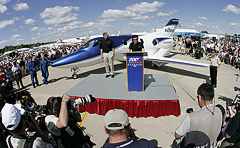HondaJet Makes World Debut At EAA AirVenture 2005
As AVweb reported last week, Honda brought its experimental HondaJet to EAA AirVenture Oshkosh last month, flying the innovative VLJ in from its Greensboro, N.C., testing base. The real news came after the show, however, when Honda executives allowed that they just may offer a certificated version of the jet. Sticking to the “this is a test bed” script, Michimasa Fujino, HondaJet project leader and vice president of Honda R&D Americas Inc., told the Oshkosh crowds, “This public world debut of the HondaJet represents the continued advancement of Honda’s long-standing dream of aviation. We are pleased and excited to be able to share this dream and our technology with the aviation community.” As we reported, the HondaJet could go for as little as $1 million or less, but will probably retail for something closer to $3 million.

 As AVweb reported last week, Honda brought its experimental HondaJet to EAA AirVenture Oshkosh last month, flying the innovative VLJ in from its Greensboro, N.C., testing base. The real news came after the show, however, when Honda executives allowed that they just may offer a certificated version of the jet. Sticking to the "this is a test bed" script, Michimasa Fujino, HondaJet project leader and vice president of Honda R&D Americas Inc., told the Oshkosh crowds, "This public world debut of the HondaJet represents the continued advancement of Honda's long-standing dream of aviation. We are pleased and excited to be able to share this dream and our technology with the aviation community." As we reported, the HondaJet could go for as little as $1 million or less, but will probably retail for something closer to $3 million. The HondaJet's configuration is unusual, however, and its acceptance in "traditional" corporate flight operations is completely unknown. One thing going for it, of course, is the company's sterling reputation for cars, motorcycles and other powered equipment. And when we say "unusual," we mean it. For example, the jet's engines are supported by patented over-the-wing pylons; the aircraft flies on a natural-laminar-flow wing; its nose is drooped; and it's powered by untested Honda HF-118 engines, each rated for 1,670-pound thrust at takeoff power. But that configuration, according to the company, features far better fuel efficiency, more available space in the fuselage and higher cruise speed than "conventional aircraft in its class." To date, the HondaJet has completed more than 156 hours of flight testing, achieving FL430 and 393 knots.
As AVweb reported last week, Honda brought its experimental HondaJet to EAA AirVenture Oshkosh last month, flying the innovative VLJ in from its Greensboro, N.C., testing base. The real news came after the show, however, when Honda executives allowed that they just may offer a certificated version of the jet. Sticking to the "this is a test bed" script, Michimasa Fujino, HondaJet project leader and vice president of Honda R&D Americas Inc., told the Oshkosh crowds, "This public world debut of the HondaJet represents the continued advancement of Honda's long-standing dream of aviation. We are pleased and excited to be able to share this dream and our technology with the aviation community." As we reported, the HondaJet could go for as little as $1 million or less, but will probably retail for something closer to $3 million. The HondaJet's configuration is unusual, however, and its acceptance in "traditional" corporate flight operations is completely unknown. One thing going for it, of course, is the company's sterling reputation for cars, motorcycles and other powered equipment. And when we say "unusual," we mean it. For example, the jet's engines are supported by patented over-the-wing pylons; the aircraft flies on a natural-laminar-flow wing; its nose is drooped; and it's powered by untested Honda HF-118 engines, each rated for 1,670-pound thrust at takeoff power. But that configuration, according to the company, features far better fuel efficiency, more available space in the fuselage and higher cruise speed than "conventional aircraft in its class." To date, the HondaJet has completed more than 156 hours of flight testing, achieving FL430 and 393 knots.






